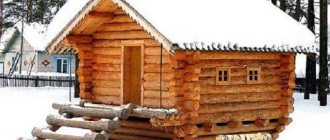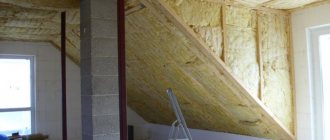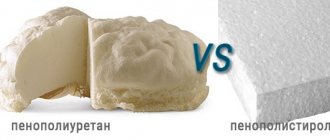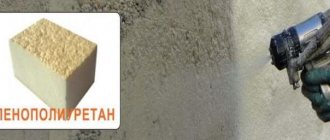With the advent of new types of insulation, the consumer has the opportunity to select thermal insulation materials according to an expanded range of criteria. But to do this, you need to have complete information on each insulation product on sale. Filling the knowledge gap for novice builders, the editors of the StroyGuru portal continue to introduce their visitors to the technologies for insulating different building structures with various types of insulation materials. Today we’ll talk about insulating walls with polyurethane foam.
Characteristics, pros and cons
Polyurethane foam is the result of a high molecular weight compound (polymers) of a polyol (component A) and a substance from the isocyanate group (component B). The polyol forms the skeleton of the material (the shell of the air chambers), and the isocyanates foam the material with the release of carbon dioxide. At the same time, a slight increase, just 1%, in polyol dramatically changes the density, hardness and other characteristics of the material. For comparison: foam rubber contains 2% component A, and hard polyurethane foam contains 3%.
Various additives can be added to the composition to change the properties of the insulation. For example, fire retardants reduce the flammability of polyurethane foam.
The procedure for installing the passage unit through the ceiling
The process of attaching the protective box itself is usually not difficult. To do this, we perform a simple sequence of actions:
- the ends are covered with thermal insulation material;
- in the passage box for the chimney, all parts in contact with the ceiling elements, as well as its bottom, are insulated;
- the pipe is carefully inserted, but it should not fit tightly to the walls;
- we secure the assembly using self-tapping screws or other fasteners;
- insulation is carried out in the attic, and the voids are filled with loose mass;
- If desired, you can decorate the structure.
Types of polyurethane foam
You can find several types of polyurethane foam on sale. They differ from each other in their state of aggregation (liquid and solid), elasticity (soft and hard), and cell structure (open and closed). Based on these classifying characteristics, several types of polyurethane foam can be distinguished:
- elastic - foam rubber, familiar to everyone from childhood, with a density of up to 20 kg/m3, open cells and good vapor permeability. Soft material always restores its shape, no matter how it is compressed or twisted. It is practically not used for insulation of building structures. It is more likely to be found when insulating metal entrance doors than on a wall or ceiling.
Foam rubber.
- hard - obtained by mixing two components: polyol and polyisocyanate. The cell structure is closed, density ranges from 30-60 kg/m3, consists of 97% air and 3% solid matter. Due to the closed structure it is vapor-tight. Used to insulate all building elements except the foundation. Can be used both outside and inside a house or apartment;
Hard polyurethane foam.
- one-component (sometimes called semi-rigid) - insulation with a density of 20-30 kg/m3, with an open cell structure. Known to many as polyurethane foam, although manufacturers have recently begun to put the inscription “Insulation” on the can. It is used only for thermal insulation of roofs and ceilings - the density is too low for walls and floors.
Semi-rigid polyurethane foam with a non-uniform structure.
- liquid _ Manufacturers, by introducing stabilizers, obtained a solution of polyol and polyisocyanate, which begins a chemical reaction only after contact with air. At the same time, the process of foam formation is slowed down, which allows you to adjust the thickness of the insulating layer. Density - 60-80 kg/m3. Vaporproof. Used to insulate flat roofs. Sometimes they try to insulate pitched roofs, but they are quickly disappointed and have difficulty finishing the work. The walls are poured into a “well” - a method of insulation using two walls: load-bearing and facing;
- sheet or solid - gas-filled plastic obtained by the molding method: liquid polyurethane foam is poured into a mold, after which it is subjected to special processing. Density about 60 kg/m3. It is used for insulation of walls, floors, including “warm” ones, and flat roofs.
PPU slabs.
Insulation characteristics
Each type of polyurethane insulation has its own physical and technical characteristics. For greater clarity, they are summarized in a table.
Table 1. Main indicators of polyurethane-based insulation.
| Types of polyurethane foam / Indicators | Rigid insulation | PPU slabs | Semi-rigid insulation |
| Thermal conductivity, W/(m×°K) | 0,022-0,035 | 0,028-0,031 | 0,025-0,045 |
| Number of closed cells, % | More than 90.0 | Not less than 95.0 | Less than 50.0 |
| Increase in volume since the start of polymerization, % | 1 in 40 | — | 1 to 70-90 |
| Vapor permeability, mg/(m x h x Pa) | 0,02-0,05 | 0,04-0,06 | 0,07-0,17 |
| Density, kg/m3 | 20,0-80,0 | 60,0-100,0 | 8,0-18,0 |
| Moisture absorption,% | 1,0-3,0 | No more than 1.5 | 10,0-60,0 |
| Compressive strength, kgf/cm2 | 1,53-10,19 | About 2.0 | About 1.02 |
| Bending strength, kgf/cm2 | 3,3-19,37 | About 3.0 | About 17.0 |
In addition to excellent thermal insulation properties, polyurethane foam has other strengths.
Advantages and disadvantages
Among the advantages it should be noted:
- the highest level of thermal insulation properties. According to this indicator, polyurethane foam is the undoubted leader among insulation materials;
- durability - service life reaches 50 years or more;
- good adhesion to walls made of any materials;
- seamless spraying, which eliminates the appearance of cold bridges;
- environmental cleanliness of the foam mass (individually the components are very toxic);
Polyurethane foam is an environmentally friendly product.
- low fire hazard - belongs to the class of self-extinguishing materials (G1);
- light weight;
- the possibility of application to surfaces of any geometry (there are no places in the building where foam cannot be blown);
- low level of water absorption;
- versatility - can be used inside and outside, on all structural elements of the building;
- ability to maintain consumer properties at temperatures from -160oC to +150oC.
There are also disadvantages . However, the disadvantages are significant:
- high price of raw materials and work on applying thermal insulation;
- intensive aging under the sun's rays;
- vapor tightness;
- complex spraying technique (knowledge of how to regulate equipment: compressor and spray gun is required);
- impossibility of application without sophisticated equipment, which also operates on a 3-phase AC system (not available in every apartment). All this complicates the insulation of polyurethane foam walls with your own hands;
- the need to strictly follow the instructions, because the slightest deviations in dosage or temperature conditions change the declared characteristics of the thermal insulation layer;
- increase in thermal conductivity during deformation during compression.
In addition, it should be noted such disadvantages as the inability to make accurate calculations on the number of sprayed components and the uneven surface of the insulating layer, which in many cases reaches a difference of up to 8 cm.
For reference: additional information about polyurethane foam can be obtained in the article “PPU Insulation”.
Limitations when insulating polyurethane foam
The use of polyurethane foam for wall insulation requires compliance with certain rules and restrictions:
- Due to the vapor permeability of polyurethane foam, the facades of wooden houses are not insulated with it - the wood rots.
- You cannot spray foam on greasy stains and polyethylene - there is no adhesion at all (it slides down).
- Semi-rigid polyurethane foam should be applied to a damp surface, hard polyurethane foam should be applied to a well-dried surface.
- You cannot start insulating walls if their temperature is below +5oC.
- When using semi-professional equipment, the cylinders must be heated to 18-20oC.
What is it used for?
PPU is designed for pipe passage through wall and ceiling ceilings; it is a round or square box with a hole. The main task is to ensure the protection of wooden floors from overheating, since during operation the temperature of the external contour of the chimney increases and heats objects in the immediate vicinity.
Such a device can be purchased in specialized stores or assembled with your own hands. When choosing a finished product, it is necessary to take into account the diameter of the chimney, as well as the location of the stove and ceilings.
For thermal insulation of the unit, basalt cotton wool rolls with a foil screen, which can be used at high temperatures, are perfect.
Required materials and tools
To insulate walls, you need to purchase a set of equipment along with components and materials for lathing, as well as vapor and waterproofing. A complete list of everything necessary to perform thermal insulation work is as follows:
- professional equipment for applying insulation (containers with components A and B, compressor station, heating unit with dispenser, supply hoses, spray gun, set of nozzles);
Technological line for spraying polyurethane foam.
Modern spraying stations.
- disposable semi-professional equipment if it is not possible to rent a professional station (pressure cylinders with components, hoses, spray gun, nozzles, a tank of pressurized water for flushing the gun from foam);
Disposable equipment.
For reference: one set is enough for 20 m2 with a layer thickness of 50 mm.
- vapor barrier film (type B);
- windproof membrane (type A or AM);
- timber for sheathing 40x60 mm;
- rail for counter-lattice 30x50 mm or 40x50 mm;
- self-tapping dowel;
- wood screws;
- hammer drill or electric drill;
- wood hacksaw;
- screwdriver;
- roulette;
- construction stapler;
- knife with replaceable blades.
In addition, in all cases, personal protective equipment will be required: a protective suit, a respirator, goggles, and hand protection.
Types of polyurethane foam
On the modern market you can find various chimney passages. The most common forms are:
- square,
- round.
It is easy to make such a device yourself if you have the skills to work with simple tools. The material can be stainless steel sheet, and basalt or expanded clay can be used as thermal insulation.
Our production
Single wall chimneys
Double wall chimneys
Mounting elements
If you decide to use a homemade pass-through unit, you should strictly adhere to the established rules to simplify further installation and ensure all standards. Below in the section we will tell you how to install it yourself.
Thickness of applied layer
To insulate the wall, it is enough to apply a thermal insulation layer 50 mm thick. However, it will not be possible to spray over the entire surface with such precision. Therefore, professionals advise working within the range of 50-60 mm, where the minimum thickness of the thermal layer is 50 mm, the maximum is 60 mm. Foam that protrudes strongly beyond the sheathing is cut off with a knife. The data is given for a brick wall of one and a half bricks.
In all other cases you need to count. To do this, you can use an online calculator (see here) or do the calculations yourself.
Insulation density
The density can be adjusted simultaneously in several ways: by changing the proportions of the components, within hundredths of a percent, by the speed and force of foam supply. Therefore, it will not be difficult for an experienced specialist to adjust the equipment to the required density. And for walls it is about 40 kg/m3.
Preparatory work
Insulation of walls by spraying polyurethane foam is carried out after preparing the walls. The work algorithm is as follows, regardless of whether the facade or walls from the inside of the room are insulated:
Important: wall insulation with polyurethane foam slabs is carried out using the technology described here. Therefore, this article is not discussed.
- everything unnecessary is removed: trim, lighting, fasteners, etc.;
- old finishing is removed. On the facade there are facing panels or decorative plaster, inside the room there is wallpaper, paint, whitewash. If necessary, leveling plaster is beaten off (where it “bumps”);
- cracks and masonry joints are sealed with repair mortar. If this is not done, the force of the foam during expansion will be enough to widen the seam or the resulting gap. We already have such experience, when in a rural school a small crack (about 2 m long and about 8 mm wide) in the brickwork was filled with foam - the wall collapsed;
For reference: the technology for preparing walls for finishing and insulation is described in detail in the work “How to prepare walls for wallpapering.”
- the wall surface is cleaned of dirt and dust. Particular attention should be paid to greasy areas (if the finish is not sealed, volatile fats will settle), which can be found anywhere. They are fat-free. If this is not done, then in such places there will be no adhesion of the insulation layer to the wall surface;
- everything where there should be no foam (floor, ceiling, door and window openings) is covered with plastic film. Then it will not be possible to clean without using various scrapers;
- the sheathing is installed. Polyurethane foam is the only type of insulation for which a sheathing frame is mandatory on the walls (for other types of insulation, the presence of a frame is determined by the insulation method). There are several reasons.
- There is no “wet” method of insulating polyurethane foam walls. But this does not mean that after insulating the facade with this insulation, decorative plaster cannot be applied. It is possible, but using a different technology.
- Serves as a guide for the thickness of the insulation layer. If mistakes are made during application, specialists remove the excess before the foam has completely hardened, as a rule. In this case, the sheathing beam serves as a beacon.
- The sheathing frame serves as the basis for cladding with subsequent finishing.
You can see how to properly install the sheathing in the work “Wall insulation with foam plastic.”
Features of ceiling cutting for a bath
To install wiring from the bathhouse, it is necessary to ensure not only the required level of safety, but also to carefully protect the steam room from heat escape.
Here the cutting is carried out in three stages:
- Preparing the site.
- Installation of a protective box.
- Careful insulation of all joints.
Insulation technology
Insulating the outside walls of a house with polyurethane foam can be done using two technologies:
- spraying on the facade;
- by pouring liquid polyurethane foam into the “well” between two walls: load-bearing and decorative.
You can only insulate walls from the inside using a spray gun. Insulation by spraying is carried out in the following sequence:
- connect the hoses from the components to be mixed to the spray gun;
- wear personal protective equipment;
- carry out primary regulation of equipment;
- carry out test spraying to check the density of the foam. If necessary, the gun and dispenser block are additionally adjusted;
- Spraying begins from hard-to-reach places, from the bottom up. The sprayer is kept at a distance of 50-60 cm from the wall. Apply in several thin layers. Each subsequent layer is sprayed only on the dried previous one. Otherwise, the thickness of the thermal insulation will be greater than planned. You'll have to cut it;
- after completing the work, all taps are turned off, the nozzle is removed, the hoses and gun are washed with a foam cleaner;
- after polymerization of the foam, the insulating layer is leveled: all protrusions are cut off;
It shouldn’t be like this: one, but a thick layer.
Important: when using open-cell polyurethane foam, the inner thermal insulation layer is covered with a vapor barrier film (type B), and the outer layer is covered with a windproof membrane (type A or AM). For two-component polyurethane foam, this procedure is not performed.
- The foam is sheathed with OSB sheets on the façade or with plasterboard from the inside of the room for further finishing. You can’t delay working outside—under the rays of the sun, polyurethane foam ages intensively.
Attention: if the foam is open-cell, then a counter-lattice is placed on top of the membrane on the façade.
Insulation of polyurethane foam using the “well” method
The method of constructing multilayer walls is widely used for insulation with foam plastic and basalt wool. It is less in demand when using expanded clay and is practically not used when insulating with polyurethane foam.
In the opinion of the editors of the StroyGuru.Com website, this situation arose due to the lack of necessary information among “home craftsmen” when building private houses on their own. After all, the method has more advantages compared to its competitors:
- It is performed by pouring rather than spraying, so there is no need to look for complex equipment;
- insulation can be carried out independently;
- the insulation will get into the most inaccessible places;
- the distance between the walls is not 15-30 cm, as for foam plastic, but 5-15 cm;
- heat is retained better.
But you should remember: you cannot insulate already finished walls by pouring insulation from the ceiling - it can squeeze out the wall, despite the reinforcement. The work is being carried out so that polyurethane foam can be poured in layers. If it is brickwork, then every 5 rows of bricks.
Insulation of polyurethane foam using the “well” method.
In conclusion, according to reviews on construction forums, it is better to entrust the work on insulating polyurethane foam to professionals. Otherwise, high prices are noted, but good thermal insulation properties.
Installation of PPU
How to install a sandwich pipe
Important information: only by using a sandwich can the temperature of the upper pipe circuit be reduced from 450° to 200°. The sandwich also helps avoid the formation of excessive condensation.
- A single-wall module, at least one meter deep, or a pipe heat exchanger is first installed on a sauna stove. Next, an adapter from a single-walled to a double-walled pipe is installed, then the use of a sandwich structure is recommended. This will reduce overheating of pipes coming from the furnace and increase their service life
- Joining pipes in interfloor and attic floors is strictly prohibited.
- The pipe can only be routed through the ceiling through polyurethane foam. After assembling the chimney, fill the free space between the side walls of the ceiling passage and the pipe with heat-resistant and non-flammable material. A material based on basalt rocks (MPB, BSTV) is recommended.
- Horizontal sections worsen traction, so we avoid them if possible. If this is impossible to do for some reason, then you should try not to make horizontal positions longer than 1 meter.
- Do not use more than three elbows in the system. Exceeding this amount reduces traction performance.
- It should be remembered that any material changes its dimensions when heated, so the pipe should not be rigidly fixed at the exit point.
After all the preparatory work, you can begin the installation of the ceiling-passage device. The chimney assembly goes from the heating unit upwards, after which it is discharged into the attic, and then through the roofing pie.
If the passage unit passes dangerously close to the joists and rafters, you need to make it yourself and install a box made of wooden blocks lined with mineralite plates on the inside. And the PPU is already installed there.
If you purchased a ready-made unit, you must follow the instructions. Factory-made polyurethane foam can be of various configurations: “empty” or with additional insulation. In the first case, it is necessary to cover the base of the unit (stainless steel sheet) with basalt cardboard from the inside, and install the polyurethane foam itself in a box protected by mineralite sheets. We leave the distance between the pipe and the sheet empty. But the assembly itself must be covered with kaolin wool to a depth of 5-7 cm from the attic side; no more is needed to avoid overheating of the pipe.
If you purchased polyurethane foam with mineralite from the Ferrum company, then this unit can be installed without an additional insulated box, as in the first option. In this case, it is also necessary to fill the void inside the unit by 5-7 cm with kaolin wool. This additional insulation increases the fire safety of the passage unit.
The assembly is fastened with self-tapping screws or with a standard fastener if you purchased a factory product. Fixation is carried out to the ceiling from above. The stainless steel platform (the base of the unit) is attached with self-tapping screws to the lining after finishing.
When installing, you need to make sure that the hole coincides with the pipe, since tilting the system is prohibited, the maximum permissible error is 1 mm.
Roof passage for round shape
At the next stage, you need to protect the attic space from moisture that gets into the gap formed between the roof. It is most convenient to use special purchased products for waterproofing this area, which are selected according to dimensions. These penetrations come in a variety of colors and are suitable for any roof. They are installed with bolts or special glue.
For better protection against leakage, you can additionally buy a sealant that carefully treats all joints. This will help ensure dryness in any climate.











